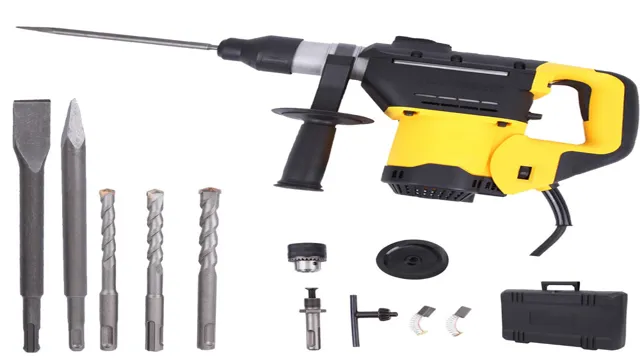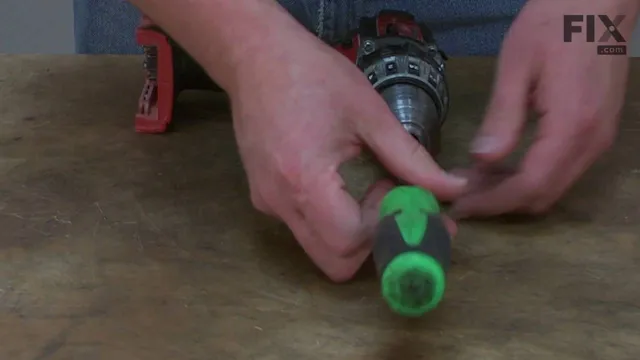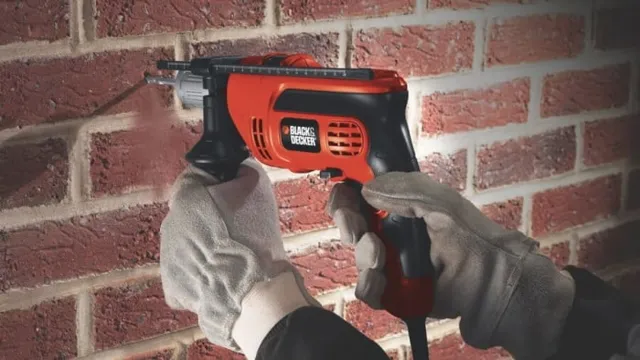Can You Drill into Concrete without a Hammer Drill? Tips and Tricks
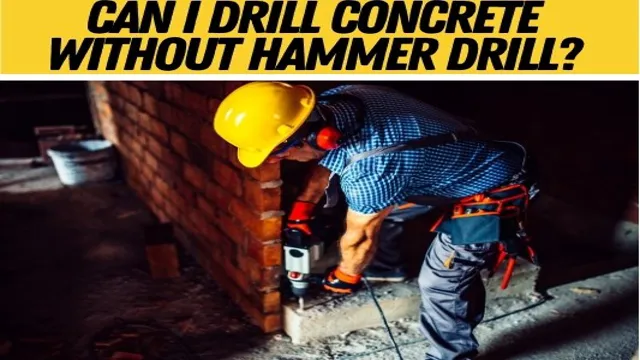
Drilling into concrete can seem like a daunting task, especially if you don’t have a hammer drill on hand. But fear not, there are other ways to accomplish this task without shelling out money for a new tool. With the right equipment and technique, you can drill into concrete using a regular drill.
Sure, it may take a bit longer and require a little more elbow grease, but the results are worth it. In this article, we’ll go over everything you need to know about drilling into concrete without a hammer drill. So put on your gloves and get ready to break a sweat!
Understanding Your Tools
If you’re looking to drill into concrete but don’t have a hammer drill, you may be wondering if it’s possible to do so with a regular drill. The short answer is yes, it is possible, but it’s not as easy as using a hammer drill. A hammer drill is specifically designed for drilling into hard materials like concrete.
It produces a pounding motion that helps break up the concrete, making it easier to drill through. A regular drill, on the other hand, simply rotates the bit without producing any impact force. This makes it more difficult to drill into concrete, but not impossible.
To drill into concrete with a regular drill, you’ll need to use a masonry bit and apply steady pressure while drilling. It may take longer to drill through the concrete, and you’ll need to be careful not to overheat the bit or damage it. So while it is possible to drill into concrete without a hammer drill, it may not be the most efficient or effective way to do so.
What is a Hammer Drill?
A hammer drill is a versatile and powerful tool that is essential for DIY enthusiasts and contractors alike. It is different from a regular drill in that it has a hammering mechanism that generates a high speed and short, rapid thrust to pulverize material such as concrete or masonry. Hammer drills come in corded and cordless varieties, and can be equipped with a range of accessories to suit different tasks.
When using a hammer drill, it’s important to wear protective gear such as gloves and eye protection, as well as follow the manufacturer’s instructions. Whether you’re building a deck or drilling into tough materials, a hammer drill is a must-have for any toolbox.
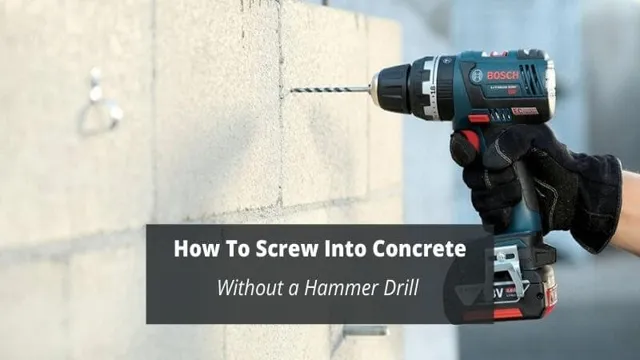
What is a Standard Drill?
A standard drill is a tool that is used to make holes in various materials including wood, metal, concrete, and plastic. It consists of a motor that rotates a drill bit to bore into the surface of the material. Understanding your tools is key to using them effectively, and drills are no exception.
When choosing a drill, it is important to consider the type of material you will be drilling into and the size of the hole you need to make. You should also consider the power source and speed options available on the drill. A cordless drill may be convenient, but a corded model may offer more consistent power.
Additionally, some models may have multiple speed settings for greater control over the drilling process. In summary, a standard drill is a versatile and essential tool for any DIY enthusiast or professional, and choosing the right one for the job is important for achieving the desired results.
Alternative Tools for Drilling into Concrete
Can you drill into concrete without a hammer drill? Yes, you can. While a hammer drill is specifically designed for drilling into hard materials, like concrete, there are alternative tools that can do the job as well. One such tool is a rotary hammer drill, which is similar to a hammer drill but with an added feature of a piston that helps the drill to generate more force and power.
Another option is a diamond-tipped drill bit, which uses diamonds to grind through the concrete and is especially helpful when drilling smaller holes. Additionally, you can use a regular drill with a masonry bit, but this method may take longer and require more effort. So, if you don’t own a hammer drill, don’t fret – there are still ways to tackle that concrete project.
Rotary Hammers
If you’re looking to drill into concrete, you might assume that a standard drill will do the trick, but the truth is that concrete is a tough material that requires a particular set of tools. Rotary hammers are some of the most popular tools used for drilling into concrete, but there are other options worth considering. One alternative is a hammer drill, which is similar to a rotary hammer but less powerful.
It works by using a combination of rotation and hammering to break through concrete. Another option is a diamond drill, which is designed specifically for drilling through hard materials like concrete and stone. Unlike the rotary hammer and hammer drill, the diamond drill uses a diamond-tipped drill bit to grind through the concrete rather than pounding through it, making it an excellent choice for precision work.
Ultimately, the best tool for the job will depend on your specific needs, so be sure to do your research and choose the right tool for your project.
Masonry Bits
Masonry bits are an essential tool for drilling into concrete and masonry surfaces, but they’re not the only option. If you find yourself without a masonry bit or if you need to drill through a particularly tough surface, there are a few alternative tools that you can use. One option is to use a carbide tipped bit, which is designed to drill through tough surfaces like concrete and brick.
These bits are more durable than regular steel bits, making them an excellent choice if you need to drill multiple holes. Another option is to use a rotary hammer drill, which is a specialized tool designed specifically for drilling through concrete and other hard materials. This tool uses a hammering mechanism to break apart the surface, allowing you to easily drill through it.
While these tools are great alternatives to masonry bits, it’s important to use them correctly to avoid damaging the surface or injuring yourself.
SDS-Plus Bits
If you’re wanting to drill into concrete, you’re going to need some specialized tools. One excellent option to consider is SDS-Plus bits. These alternative tools can make all the difference, allowing you to drill deeper and more efficiently than a standard drill bit.
One of the reasons for this is the unique design of SDS-Plus bits. They feature a special shank that allows for better power transfer between the tool and the bit, reducing vibration and wear and tear on both. Additionally, SDS-Plus bits have a special fluting that helps to quickly clear dust and debris out of the hole as you drill, allowing for faster progress and a clean, smooth finish.
When you combine all these factors, it’s easy to see why SDS-Plus bits are such a popular choice for professional contractors and DIY enthusiasts alike when it comes to drilling into concrete.
Techniques for Drilling into Concrete Without a Hammer Drill
If you need to drill into concrete but don’t have a hammer drill, no need to worry; there are still techniques you can use to get the job done. One option is to use a masonry drill bit and a regular power drill. While it may take longer, these drill bits are designed to handle harder materials like concrete, brick, and stone.
It’s important to start with a smaller bit size and gradually work your way up to prevent any damage to the drill or surface. Another option is to use a rotary hammer drill, which operates similarly to a hammer drill but has a special chisel function for breaking through concrete. Finally, if you’re really in a pinch, you can use a good old-fashioned hammer and chisel to create a small hole and gradually work it larger.
While it may not be the quickest or easiest option, it can be effective if you only need a few small holes. Overall, while a hammer drill can make the job easier, there are still various techniques you can use when drilling into concrete without one.
Applying Pressure
Applying Pressure When it comes to drilling into concrete without a hammer drill, applying pressure is key. Start by using a drill bit designed for concrete and attaching it to a regular drill. Then, firmly press the bit onto the surface of the concrete and begin drilling slowly, using steady pressure and keeping the drill level.
If you encounter resistance, stop drilling and apply more pressure before continuing. Another technique is to use a screwdriver or chisel to create a small indent in the concrete where you want to drill, as this gives the drill bit a starting point and makes it easier to drill into the surface. Remember to take breaks as needed and to wear protective gear like safety goggles and gloves, as drilling into concrete can create flying debris and dust.
With patience and persistence, you can successfully drill into concrete without a hammer drill using these techniques.
Lubricating the Bit
When it comes to drilling into concrete without a hammer drill, lubrication can be a game-changer. Using a lubricant such as oil or grease can make the drilling process smoother and faster, reducing the risk of the drill bit overheating and becoming dull. Before drilling, apply a small amount of lubricant to the tip of the drill bit.
This will help the bit glide through the concrete and prevent it from getting stuck. It’s important to check the lubricant frequently and reapply as necessary, as the bit will start to get hot and dry out the lubricant. Not only does using a lubricant improve the efficiency of the drilling process, but it also prolongs the life of the drill bit itself, saving you time and money in the long run.
Don’t underestimate the power of lubrication when it comes to drilling into concrete without a hammer drill!
Using Water
Drilling into concrete without a hammer drill can be a challenging task. Luckily, there are a few techniques you can use that don’t involve a lot of expensive or specialized equipment. One common method is to use water to lubricate the drill bit and keep it cool.
Simply fill a spray bottle with water and spray it onto the concrete as you drill. This will help prevent the bit from overheating and potentially breaking. You can also use a hose to create a continuous stream of water over the area where you are drilling.
Another option is to use a masonry nail to create a small starter hole in the concrete. Once you have the starter hole, you can use a regular drill bit to finish the job. With these techniques, you don’t have to let the lack of a hammer drill prevent you from tackling your concrete drilling projects.
Conclusion
In conclusion, attempting to drill into concrete without a hammer drill is like trying to cut bread with a spoon – it’s possible, but it’s going to take a lot of effort and probably won’t result in a clean cut. Besides, you don’t want to risk damaging your trusty power tools or, even worse, injuring yourself in the process. So, save yourself time and frustration and invest in a hammer drill – your arms (and your sanity) will thank you.
“
FAQs
What are the tools needed to drill into concrete without a hammer drill?
To drill into concrete without a hammer drill, you will need a masonry drill bit, power drill, extension cord, safety goggles, and hearing protection.
Can you use a regular drill to drill into concrete?
Yes, you can use a regular drill to drill into concrete as long as you have the right masonry drill bit, use the correct speed and technique, and take safety precautions.
How do you choose the right masonry drill bit for concrete?
To choose the right masonry drill bit for concrete, look for one with a carbide tip, a diamond tip, or a cobalt blend. Make sure the bit is designed for use with a hammer drill or a regular drill with a hammer function.
What speed should you use when drilling into concrete without a hammer drill?
When drilling into concrete without a hammer drill, use a lower speed setting on your drill to avoid overheating the bit. Start with a low speed and gradually increase it until you find the best speed for your particular job.
How do you achieve the best results when drilling into concrete without a hammer drill?
To achieve the best results when drilling into concrete without a hammer drill, use a steady pressure, keep the drill bit cooled off with water, and clear the dust from the hole frequently. Take breaks as needed to avoid overheating the drill or the bit.
Can you drill into reinforced concrete without a hammer drill?
It is difficult to drill into reinforced concrete without a hammer drill as the rebar can cause the drill bit to deflect or break. If you must drill into reinforced concrete without a hammer drill, choose a bit with a carbide tip and use a low speed and steady pressure.
How do you repair holes drilled into concrete without a hammer drill?
To repair holes drilled into concrete without a hammer drill, clean out the hole thoroughly, fill it with hydraulic cement, and allow the cement to dry completely. You can also use an epoxy or concrete patching compound to repair the hole.

